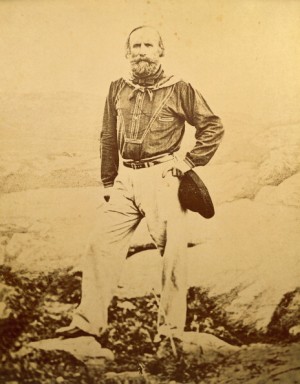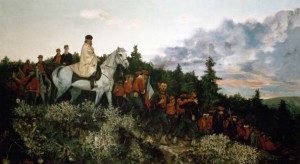| Giusepe Garibaldi | |
|---|---|
| Italian General and Politician | |
| Years of Service | 1860-1879 |
| Born | July 4, 1807 Nice, France |
| Died | June 2, 1882 Caprera, Italy |
| Nationality | Italian |
| Political Movement | Unification of Italy |
One of the important figures in the unification of Italy in the 1800s was Giusepe Garibaldi. Rather than using revolutionary methods to accomplish his political goals, Garibaldi often searched for legitimate ways to wield his influence. He was also a recognized military leader with the respect of his soldiers. In addition to helping unify Italy, his accomplishments include being General of the Roman Republic and leading the Expedition of the Thousand.
Early Life
Giuseppe Garibaldi was born in 1807 in Nice (“nizza”), France, to Giovanni Domenico Garibaldi and Maria Rosa Nicoletta Raimondo. His father was in the sea trade business and this enveloped the young Giuseppe with a worldview that looked outward toward the bustling commerce of markets and the politics which influenced global trade. But the city of his birth would also shape the theme of his life. The reason is that at the time, the country of loyalty to which the city of Nice should belong had been a matter of dispute since medieval times. For centuries, the majority of the residents of Nice were Italians (who called their city Nizza). These Italians of Nice are known to history as the Nizzardo Italians, which included the Garibaldi family. The Nizzardos were passionate that Nice, be made a city of Italy, but the powers of France equally coveted this highly desirable, rich and fertile local region of Europe.
Finding a Calling
In his mid-twenties, Giuseppe Garibaldi earned his certification as a captain of a merchant marine vessel and shipped out with a load of oranges to Russia. In the city of Tagnarog, Garibaldi met a man who helped shape the direction of his life. This man was an associate of Giuseppe Mazzini, the man who would become known to history as the driving force or “beating heart” of the Italian Unification movement. In 1833, Garibaldi met with Mazzini in Geneva. Before long, Garibaldi fully adopted Mazzini’s vision of a unified Italian state and pledged his oath and loyalty to both Mazzini and the cause.
In the Meantime
It would be many years before Garibaldi became actively engaged in the fight for a unified Italy. His travels with the merchant marines took him around the world and he eventually landed in Brazil where he quickly became embroiled in the politics of that country.
Garibaldi aligned himself with a particular state within Brazil—Rio Grande do Sul—which wanted to secede to form its own country because its people felt they were being economically oppressed by the Brazilian regime. In 1836, Garibaldi hired on as a soldier, or commanding officer, working under General Bento Gonçalves da Silva and General Antônio de Sousa Neto. It was also during this period that Garibaldi met Ana Ribeiro da Silva, a Brazilian woman whom he married in 1839. In the years to follow, they fought side-by-side in several battles. During that time, the couple also bore four children.
But the cause of Rio Grande do Sul was destined to fail. The revolution was crushed by 1845 after about 10 years of bloodshed, heartbreak, and loss. As for Garibaldi, he became a battle-hardened veteran during this fight for independence against Brazil. He used these experiences in numerous future causes, both in South America and back in his homeland of Italy.
By 1842, Garibaldi had moved on to Uruguay where he raised an Italian legion which fought in the Uruguayan Civil War. In this conflict, Garibaldi proved himself an able military leader. He won a number of key victories and this time ended up on the winning side. It was here where he developed his famous band of “Red Shirts.” Despite this success and his interest in the regional politics of South American nations, Garibaldi never forgot about the ultimate cause close to his heart—the unification of Italy.
Returning to Italy
In 1846, the election of a new pope, Pius IX, caused a sensation in Italy. That was because Pius IX was not just the leader of the Catholic Church, but his position also made him a kind of “secular king” of all the papal states of Italy. Revolutionaries such as Mazzini and Garibaldi saw the ascension of Pius IX as the key factor they needed to implement their plan to bring all factions of Italy together under a single, unified nation.
Garibaldi wrote to the pope and offered him the services of his battled-hardened Italian Legion tested in the Uruguayan Civil War. He returned to his homeland in 1848, when the county was in a considerable state of strife, internal conflict, and turmoil.
During the years of 1848 and 1849, Garibaldi and his troops would be involved in intense fighting over the control of Rome. His primary enemy was the French, who were eager to maintain their political and military control over Vatican territories, Rome and other so-called papal states. Garibaldi achieved a number of victories in these conflicts, but the French eventually prevailed. In one of the conflicts, his wife was killed during a prolonged march of retreat. She was pregnant with their fifth child at the time of her death.
To America and Beyond
After the French reasserted control of their Interests in Rome, Garibaldi fled and ended up in America for a short period. He worked at a candle factory before he re-entered the world of trading at sea to work as a ship’s captain in the merchant marines for a variety of interests.
He eventually found his way back to Italy, however, where the movement for Italian unification and independence was in a constant state of boil. Garibaldi again commanded military forces and won significant victories at the rank of major general in the Second Italian Civil War. He also scored a highly significant military victory in what is known as the “Expedition of the Thousand.” This was a conflict that would bring southern Italy under the umbrella of a new, unified Italian state.
War and Politics
Giuseppe Garibaldi would remain involved in the political struggles of 19th century Italy—and all of Europe for that matter—until his death in 1882 at age 75. Statues and monuments to Garibaldi can be found not only all over Italy today, but throughout Europe, Russia and many locations in South America, including Brazil and Uruguay.


